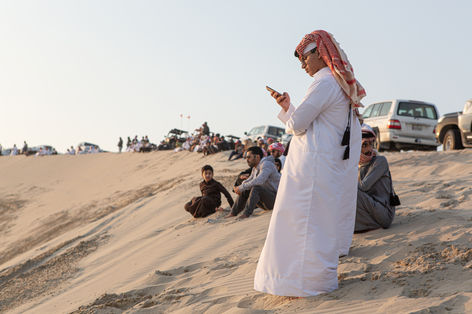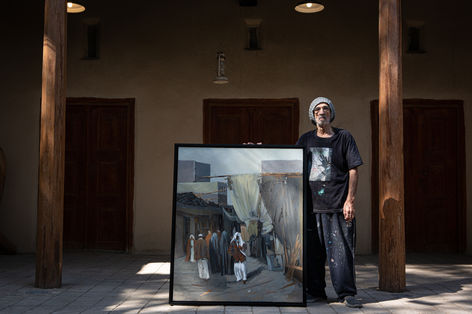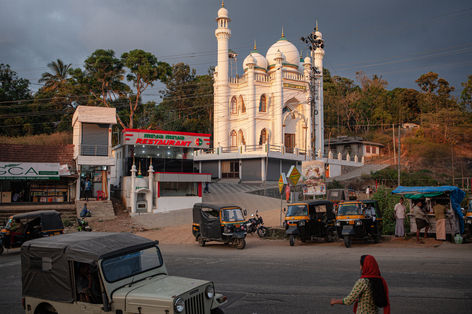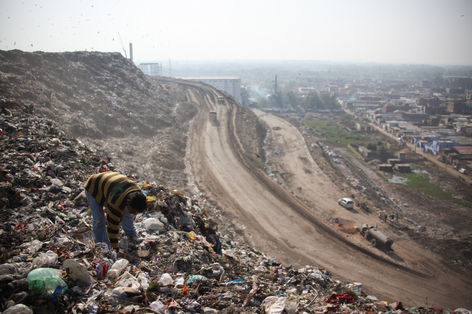Consumerism
Asia is a rising player in global consumerism. India is expected to become one of the leading consumer market in the 21st century. The average share of an Indian citizen's monthly budget spent on durable goods already doubled between 2000 and 2023. Durable goods have a substantial initial environmental footprint due to the amount of resources and energy that is required to produce them.
But Human comfort, often branded as the ultimate societal goal, has silenced questionings of lifestyles that are growingly insulated from the natural world. As income levels rise across the Asian continent, demand for environmentally-intensive services like international tourism is expected to surge.
The following are excerpts from reports conducted on consumerist patterns in Asia.
All images © Sebastian Castelier
0°C Playgrounds in a Warming Desert
Oman 🇴🇲 - Temperatures in the Arabian Peninsula could rise 6.3°C above 1850–1900’s pre-industrial levels by 2100 in the business as usual scenario. Confronted with warmer outdoors, the region has doubled down on air-conditioned spaces. Following Snow Dubai's 2005 launch, 0°C leisure has spread across the region. “In the summer, you cannot do any outdoor activities in Oman, it is too hot, so the best place to go is Snow Oman,” said Hamna Arif, a Pakistani living in Oman. "They should add more animals, like polar bears or seals for example,” suggested Sahar Derakhshani, an Iranian citizen in Muscat.
West Asia's 0°C playgrounds, such as ice skating rinks, snow parks and Saudi Arabia's first outdoor skiing station under construction, come with a water footprint. Ski Dubai produces 30 to 40 tonnes of snow daily from fresh water to renew its snow cover, which is recycled two times, including to irrigate.
Africa’s Vanishing Wild for West Asia’s Vanity
Kuwait 🇰🇼 - West Asia is fond of exotic pets, including cheetahs and lions, smuggled out of Africa to be exhibited as status symbols. "A lot of people here like challenges, and they do not want a classic pet ... It is also about looking different from ordinary people. ‘If I can deal with such an animal, it means that I am superior'.” said Kuwaiti psychologist Adnan Al Shatti.
"They are my babies. I would prefer them to my children if I had any" said Shahad Al Jaber, a Kuwaiti who owns two cheetahs that she has smuggled into the emirate after bribing employees at Kuwait International Airport. West Asia's craving for status symbols encourage a destructive trade that devastates African wildlife, after the species had already been extirpated from the Arabian Peninsula's vast deserts, where it once roamed free. In the wild, only about 6,500 cheetahs remain, and the world’s fastest land animal is ranked vulnerable on the IUCN Red List.
From Living with Deserts to Driving Over It
Qatar 🇶🇦- Every weekend during winter, Qataris gather in Khor Al-Adaid in the country's southeastern corner to celebrate fuel-intensive cars. There, they practice dune bashing, a form of off-roading popular in the desert region. "It is our weekend outing, like going to the cinema but more exciting and free." said Faisal Al Balushi, a Qatari soldier. "Their 4x4 is part of their identity and their masculinity," said Ahoud, a Qatari female student. It is estimated that 60% of Qatari men own a four-wheel drive.
Similar dune bashing gatherings are common across the region. It reflects an increasing trend of commodification of the natural environment among youth throughout the Arabian Peninsula. "Qatar's economic development has been so rapid that people have forgotten their roots, including living with nature, which people were attached to," Neeshad Shafi, co-founder of the Arab Youth Climate Movement Qatar, a non-profit organisation.
Painting What Fossil Fuels Swept Away
Kuwait 🇰🇼 - West Asia underwent sudden transformation in the second half of the 20th century. Fueled by petrodollars, the region paved over its past to build car-centric cities inspired by the United States’ 1950s suburban dream and entrench a culture of mass consumption. As modest, nature-bound lifestyles fade from living memory in the Arabian Peninsula, painters who lived the pre-oil era are among the last living links to that past.
The radical metamorphosis of lifestyles inspired Ayoub Hussein Al Ayoub, a Kuwaiti painter born in 1932. "His life mission was to urge Kuwaitis to show their children and grandchildren what life was like before oil, and never to forget it." said Taghreed, his daughter. After his passing in 2013, his 800 paintings left behind a rare artistic archive of Kuwait's pre-oil era. "It prompts us to think about our luxury-driven way of life." said Abdallah Al Massaeed, 22, viewing one of Al Ayoub's paintings in a museum.
How West Asia colonised India's Minds
India 🇮🇳 - The South Asian labor force has formed the bedrock of the Arabian Peninsula's economy for decades. Today, nine million Indians work in the region. "Migration has been their bridge to heaven!”, said Irudaya Rajan, a migration researcher. But migration routes have played an instrumental, yet indirect, role in West Asia's efforts to promote energy-intensive lifestyles that fuel global demand for fossil fuels, its main export product.
Khadeeja Manithodika, whose son works in Saudi Arabia, said: "Air conditioners have become a badge of social prestige here." India's installed air conditioners is expected to increase 38-fold to 1.1 billion by 2050. Migration has also eroded Kerala's vernacular Islamic architecture, replaced by air-conditioned mosques made of heat-trapping concrete. India-Arab ties researcher M. H. Ilias said: "The Gulf has become our reference point ... We have named it the 'Dubai elsewhere' phenomenon.”
The Limits of a consumerist World
India 🇮🇳 - The throwaway age leaves behind towering mounds of waste. In India, where one landfill is nicknamed Trash Mountain, 50% of solid waste are discarded in wasteyards. Though considered cost-effective, India's 3,100 landfills carry long-term environmental costs as toxic substances leach into soil and water over years. Also, landfill are major emitters of methane, an Earth-warming gas that has a global warming potential 28 times greater than CO2 over a period of 100 years.
As landfill remains the dominant waste solution in West Asia, Qatari recycler Elite Paper Recycling reports diverting up to 4,500 tons of paper and cardboard monthly in the emirate. Still, the promise of endless recycling, often used to excuse excessive consumption, is a myth. In practice, paper can only be recycled only five to seven times as fibers degrade during each recycling cycles. What follows is downcycling into lower-value products.













































